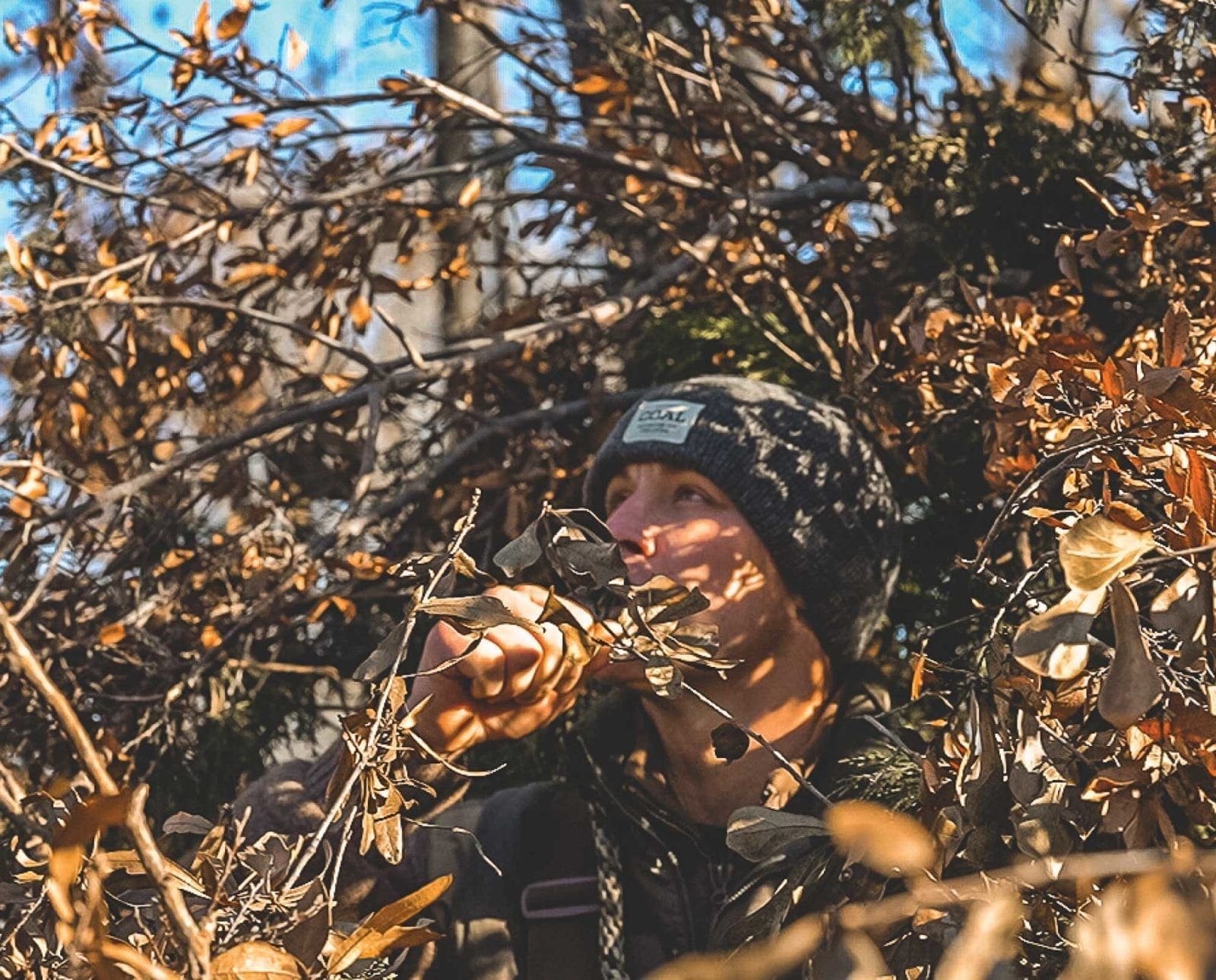Home » Waterfowl Hunting » Duck Blind Quick Tips and Hacks
Duck Blind Quick Tips and Hacks

Brad Stefanoni grew up hunting quail and waterfowl in southeast…
The perfect duck blind may not exist, but these tips will help improve your setup this season
For more than thirty years I have been on a quest to build the perfect duck blind. It must be the right shape and size. It has to be located in just the right spot. It must hide like a needle in a haystack. And, it must have enough leg-room so I don’t feel like a frozen pretzel after camping out in it for four hours.
They say that admitting you have a problem is the first step toward recovery. While I’m not admitting to anything, I will state before my duck hunting brethren that I do not believe the perfect duck blind exists. It’s my own personal Holy Grail, but I feel not even Indiana Jones will be able to find it.
Rather than continue to search for a unicorn, I’d like to share some of my personal duck blind “hacks” gleaned from over thirty years of trying to build a better mousetrap.
Location, location, location
This cliché is overused but it’s true. After you have built, decorated, hunted from, then moved enough duck blinds, you eventually learn two undeniable truths of duck blind placement:
- Place your blind where the ducks want to go
- Use available natural cover to more easily hide your blind
Many moons ago, a friend and I watched flock after flock of ducks funnel into a small pond one morning. After securing permission,we hastily built a blind in what we thought was a strategic spot. That whole first year, we took marginal shots at ducks decoying at the edge of shotgun range. Toward the end of that first season my hunting partner said, “Forget this; I’m going to go stand next to that willow tree and shoot ducks at twenty yards instead of forty!”
We both used the willow tree as cover and shot our limits of mallards in less than an hour. Before the next season started, we relocated our blind next to the willow tree and enjoyed some great hunts for the next few years. The takeaway here is to put in the time to figure out where the ducks naturally gravitate to, then use available natural cover to help hide your blind.
There are no right angles in nature
My longtime hunting partner’s father reminds us of this truth multiple times each season. It annoys us but we also know he’s right, darn it!
While driving home from a recent trout fishing weekend, I spotted a large, box-shaped duck blind parked on the edge of a farm pond. I pointed it out to my family, “Heck, if I can see that duck blind a half-mile away while driving 65 miles per hour, don’t you think the ducks can pick it out like an NFL stadium from 1,000 feet in the air?”
Conversely, I once came across photos on the internet of a duck blind in a beaver swamp that looked exactly like a beaver lodge. It was shaped like a wide dome and covered in logs chewed by beavers. Under all those logs was a spacious blind that blended perfectly with its surroundings. Whoever hatched that idea was brilliant. The edges were rounded and smooth, not sharp and angled like a typical box blind.
Find any way you can to soften the hard edges of your duck blind. One trick is to bundle up some grass or brush and bind it all together in the center with a plastic cable tie. The tighter you pull the cable tie, the more the ends flare out in a natural spread. I place these bundles along all the hard edges of my blind’s roof to soften the edges.
Carry a duck blind toolkit
One piece of gear I always have in my duck blind is a small toolkit filled with a handful of essential items for small repairs, camo fixes, and decoy rigging. Any small toolbox or fishing tackle box will work, but I like the MTM Sportsman Dry Box because it’s durable and sealed with an O-ring to make it waterproof.
Items in my toolkit include:
- Knife
- Pliers
- Cable ties
- Screwdriver with interchangeable bits
- Extra decoy anchor cord
- A few extra decoy anchors
- A roll of paracord
- Duct tape (What’s a toolbox without duct tape, right?)
- Small container of cleaner/lubricant/preservative (CLP)
- Shop rag
- First aid kit
- Waterproof matches and lighter
- Small roll of biodegradable toilet paper (self-explanatory)
The smaller the container, the better; you don’t want to take up too much real estate in your blind. Get creative like you are gearing up for a backpacking trip and maximize your contents-to-available-space ratio.
Duck blind space saving tips
Space in a duck blind is a valuable commodity, so you must think creatively to maximize your space while not leaving essential items behind. Watch a few tiny house programs on HGTV for inspiration and you’ll be surprised how many ideas can transfer to a duck blind.
- If you use chairs, use folding chairs. Shop thrift stores and flea markets to pick up a few on the cheap.
- If you use bench-type seating, then build a box instead of a simple plank bench. That wasted space under your rear end is a great place to store items out of the way but still easily accessible.
- If you need some horizontal workspace, look for a small folding table like an old TV tray. Walmart or Target usually has a few inexpensive options, too.
- Don’t set gear on the blind floor; instead, hang it up. Strategically-placed screw-in hooks or simple deck screws will keep items within arm’s reach and out from underfoot. This contributes to safety, too.
- Have your retriever outside of the blind if you can. My Lab has her own “duck blind” right outside my pit blind where she can watch ducks and make retrieves without being in the way. This also prevents us from getting free showers when she shakes off excess water.
Make time and space for some creature comforts
I used to hunt with an old timer who always said, “Kid, I came out here to smooth it, not to rough it.” Misery and a successful duck hunt don’t always have to go hand-in-hand, so don’t be afraid to include a few items that create a slightly more civilized home-away-from-home.
Light is a mainstay in my duck blind. A few well-placed battery-powered LED lights brighten up those pre-dawn hunt preparations and ensure an added element of safety. Climbing in and out of a blind and loading shotguns in the dark is challenging; it’s also not the safety example to set when mentoring young or new hunters. A simple flashlight or headlamp is also a great thing to bring along.
One more creature comfort that is always in my blind is a small propane heater. I know, I know; some will deride me as a wimp, but late season in Kansas can be brutal and a small heater can be the difference between freezing out after thirty minutes or sticking around for the late flight of greenheads. It’s also critical when you have young hunters in the blind because no words can put the brakes on a duck hunt faster than, “Dad, I’m cold.”

Make safety a priority in the duck blind
I cannot stress safety too much. Duck blinds are places with shotguns, live ammunition, slippery floors, and excited retrievers running a human obstacle course. It might get repetitive to keep asking everyone if safeties are in the “on” position and if shotgun muzzles are pointed in safe directions, but it matters.
Anti-fatigue mats found at Home Depot or Lowes are a great way to ensure solid, non-slip footing in duck blinds. They can be cut down if necessary to cover the areas where hunters will be standing or walking. A twenty dollar investment may stand between you and an unfortunate, preventable accident.
Secure shotguns in the blind with a foam barrel grip or a screw-in tool hanger to ensure that a shotgun can’t be accidentally knocked over. Again, the cost of these items is insignificant compared to the unthinkable firearm accidents they can prevent.
This is, of course, just a fraction of the countless ways to trick out your duck blind. My hacks have been cultivated by more than thirty years of sitting in duck blinds; the good, the bad, and the ugly. If you’re like me, you likely have some time on your hands to think while waiting for the next flock of ducks to visit your decoy spread. Use that time wisely to continually improve your blind, always chasing the unicorn of the perfect duck blind setup.
Brad Stefanoni grew up hunting quail and waterfowl in southeast Kansas, where for the past 20 years he’s been passing on what he learned to his wife and their two sons. His diverse background includes work as a biologist, a science education center director, an outdoor writer and a developer of public/private partnerships. With a degree in wildlife biology, Brad’s current work-in-progress is transforming his family’s 80-acre farm into a living laboratory of upland and wetland habitat. His passions include spending time with his family and black Labrador retriever pursuing waterfowl and upland birds, and fly fishing.




